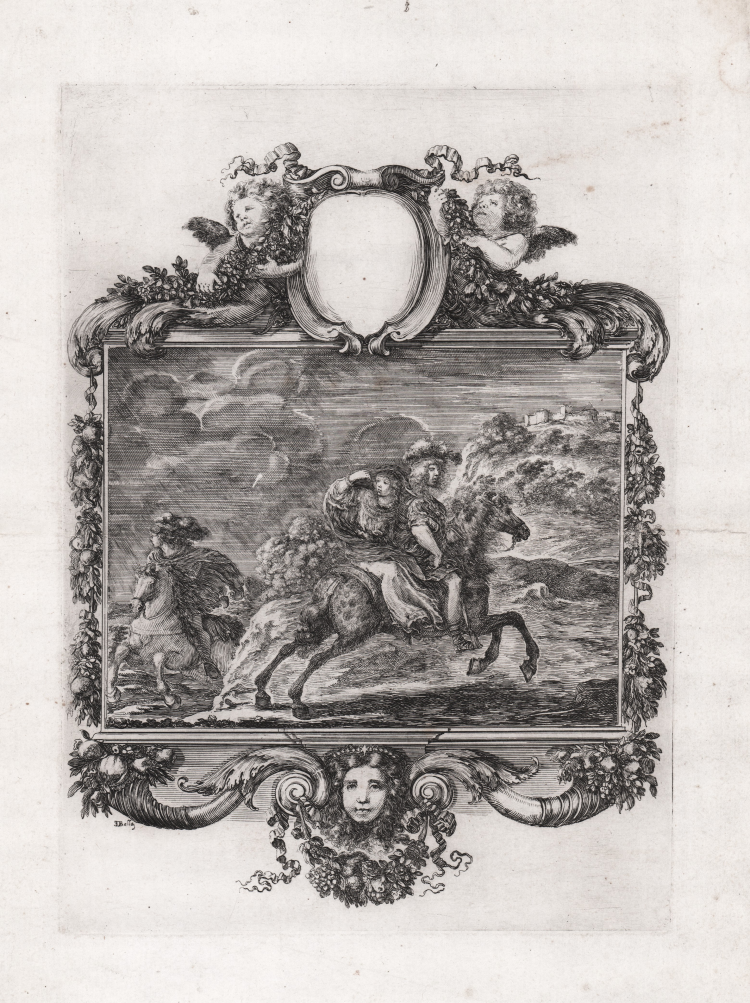




| Reference: | S40261.17 |
| Author | Stefano Della BELLA |
| Year: | 1655 ca. |
| Measures: | 277 x 307 mm |



| Reference: | S40261.17 |
| Author | Stefano Della BELLA |
| Year: | 1655 ca. |
| Measures: | 277 x 307 mm |
Etching, 1665 circa, signed within image "SDBella". Only state.
Magnificient example, printed on contemporary laid paper, unusual wide margins, in excellent condition
Contrary to De Vesme's doubts that the subject of this print is Clovis enlevant Clotilde, the traditional title is probably correct. As Blunt points out, (in The Drawings of G. B. Castiglione and Stefano della Bella, p. 94), a very similar idea was used by another engraver as a frontispiece for Clovis, ou la France Chrestienne, by the French author, Desmarets de Saint-Sorlin. De Vesme's reason for discounting the Clovis and Clotilde subject was that it would have had no interest in Italy, where he was sure the plate was etched.
The plate was later inventoried in the Grand Duke's collection in Florence. No impressions are dated and no publisher is named.
Though Stefano did send plates to his Paris publishers during the 1650's, the impressions they issued probably, though not certainly, would bear their names and a privilege. There exists the possibility that the plate was etched in Paris, but brought to Italy by the artist when he returned in 1650.
Stefano della Bella was one of the most interesting and original engravers in 17th-century Florence and can be considered the only brilliant continuator of Jacques Callot's work. His artistic education began in Florence in the workshop of the goldsmiths Gasparo Mola and Orazio Vanni, and the precision of sign, typical of the goldsmith's art, will remain characteristic of his style. He then studied under Giovanni Battista Vanni and perhaps also under Cantagallina and Cesare Dandini, but soon turned to engraving. His real master can be considered Jacques Callot, the French engraver who stayed in Florence for a long time and left a strong imprint on the city's artistic scene.
The most important years of his career were the ones he spent in Paris, from 1639 to 1650, salaried by Lorenzo de' Medici: he worked together with Israel Silvestre, with the publishers Langlois, Ciartres and Pierre Mariette, for French printers and for commissions of great prestige, such as those of 1641 for Cardinal Richelieu, who entrusted him with illustrations of his warlike exploits.
Around 1647, during a trip to Holland, where he executed etchings with views of the port of Amsterdam, he met Rembrandt, and from that date we note a profound echo of the Dutchman's art in Della Bella's graphic work.
Bibliografia
De Vesme - Massar Stefano della Bella (1971) n. 211.
Stefano Della BELLA (Firenze 1610 - 1664)
|
Stefano della Bella was one of the most interesting and ingenious artists of XVII century in Florence and can be considered as the sole real follower of Callot. He was educated in Florence at first, in the studio of Gasparo Mola and Orazio Vanni; this experience gave him a firm and careful hand when using the graver. He then went to Giovan Battista Vanni’s and, very likely, he also studied with Cantagallina and Cesare Dandini but, as Baldinucci said, he was still very young when he decided to leave painting and devoute entirely himself to engraving. His real master, then, can be considered Jacques Callot, the French engraver who lived for long time in Florence spreading his influence all around the city.
Lorenzo dè Medici became soon Stefano’s patron and invited the young artist in Rome between 1633 and 1636; in the Eternal City, the artist realized many copies from the antiquities and from Polidoro’s works. In 1633 he realized his first noteworthy work: Entrata a Roma dell’ambasciatore di Polonia Giorgio Ossolinsky.
In 1639 Stefano went to Paris where he lived, until 1650, out of a pension Lorenzo dè Medici had granted to him.
Around 1647, when travelling along the Netherlands, he met Rembrandt; from that moment the influence of the Dutch artist can be found in the entire Della Bella’s production.
|
Stefano Della BELLA (Firenze 1610 - 1664)
|
Stefano della Bella was one of the most interesting and ingenious artists of XVII century in Florence and can be considered as the sole real follower of Callot. He was educated in Florence at first, in the studio of Gasparo Mola and Orazio Vanni; this experience gave him a firm and careful hand when using the graver. He then went to Giovan Battista Vanni’s and, very likely, he also studied with Cantagallina and Cesare Dandini but, as Baldinucci said, he was still very young when he decided to leave painting and devoute entirely himself to engraving. His real master, then, can be considered Jacques Callot, the French engraver who lived for long time in Florence spreading his influence all around the city.
Lorenzo dè Medici became soon Stefano’s patron and invited the young artist in Rome between 1633 and 1636; in the Eternal City, the artist realized many copies from the antiquities and from Polidoro’s works. In 1633 he realized his first noteworthy work: Entrata a Roma dell’ambasciatore di Polonia Giorgio Ossolinsky.
In 1639 Stefano went to Paris where he lived, until 1650, out of a pension Lorenzo dè Medici had granted to him.
Around 1647, when travelling along the Netherlands, he met Rembrandt; from that moment the influence of the Dutch artist can be found in the entire Della Bella’s production.
|